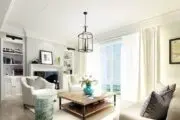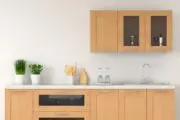While a growing number of homeowners indicate that having dedicated space for exercise is a priority, the reality is that home gyms are often an afterthought, relegated to whatever room or corner is available.
“When looking at a new house, house hunters usually ask if the kitchen is big enough or if the dining room works for entertaining, but people don’t usually look at possible gym space,” says Evan Lyons, managing director, Ardent Fitness.
Functionality, appearance and location will not only influence your home’s overall design but may also alternatively encourage or deter you from reaching your fitness goals, so time spent planning is time well spent.
Consider this. It’s common to tuck away a home gym in a section of the basement, but “no one wants to work out in an unfinished basement,” next to boxes of storage items, says Lyons.
Creating a home gym that you’ll love to use requires attention to specific design criteria and an understanding of what your fitness goals are, and how your choices will create a space that is motivating.
What are your goals?
The key to a function-first design is to establish your fitness goals and your preferred exercise style and then design a space that is appropriate, within the available square footage that you have.
- Are you looking to boost cardio or increase strength?
- Do your fitness goals include meditation and yoga?
- Does your exercise routine involve a dance or martial arts component?
- Do you stream fitness classes?
- Do you want to bring in a personal trainer?
- How many people in the household might be working out at the same time?
Once you’ve determined what you want to accomplish in your gym, you can work on the design.
What equipment do I need?
Ultimately, how you equip your gym will matter a great deal on how much space is available, but there are a few essentials: cardio, strength training and recovery.
“For cardiovascular workouts, a piece of equipment such a treadmill or an elliptical machine are popular. However, if space or budget is a constraint, smaller items such as jump ropes or a stationary bike can be effective alternatives,” says Tanya Ryno, designer and owner of Iron House
For the strength training component, Ryno suggests, “A set of adjustable dumbbells can be a versatile and space-saving option, offering a range of weights in one compact design. For those interested in more intensive strength training, investing in a multi-gym machine or a set of kettlebells might be more appropriate.
“However, it’s important to consider the space required for such equipment and the user’s experience level,” she says.
Even if space is at a premium, don’t skimp on a recovery area, says Lyons.
“A lot of people neglect a recovery space, and it is becoming more and more scientifically proven that recovery is really important. There is a reason that every pro sports team now has recovery rooms in addition to their gym,” he says.
A yoga mat, stability ball, massage gun or foam roller all aid with recovery and are easily stored away if space is short.
What’s the best location for your home gym?
From a flex room to a corner in the basement, to a garage, to an outdoor exercise space, the options for a home gym are many.
The main criteria? Place your gym in a location in your home that you like to go to, because you will be more likely to make it a habit.
“Your gym has to be in a place you’re comfortable and you want to be,” explains Lyons. “Even if you put one piece of equipment in your bedroom, at least it’s a space you’re comfortable,” he says.
Ideally, a home gym would be separate from the other areas of the home, to help reduce noise and allow for privacy.
Having a window that opens is desirable, both for natural light and cross-ventilation purposes, but that isn’t always possible.
Make sure your gym location has adequate and appropriate lighting (think pot lights or similar task-focused fixtures) as opposed to harsh, industrial lighting.
A solid ventilation system is a must to help with odor, so proper ducting and/or a fan are recommended, especially if you can’t open a window.
What design choices are recommended?
First, homeowners should look at the ceiling height in the room. Having higher ceilings is preferable, because of greater clearance while exercising.
“Ceiling height is crucial, especially for equipment such as power racks or for exercises that involve jumping or overhead lifting. A minimum height of eight feet is advisable, but 10 feet is ideal for functional training or activities like rope skipping or HIIT. A ceiling height of 12 feet or more adds a grander feeling to the space, “says Ryno.
Choosing the right flooring for durability and injury prevention needs to be carefully considered.
Rubber is traditionally the go-to gym floor material and is available in a range of colors. Rubber is a good choice for homeowners who might be “dropping heavy weights or doing CrossFit,” says Lyons.
As style is evolving in the fitness space, so are décor choices for homeowners.
“There’s a whole new line of laminate products that look like a high-end wood floor but they perform like a gym floor,” a choice that Lyons recommends to homeowners to make their gym look less industrial and more inviting.
Perhaps the most important (and often overlooked) design choice in a gym? Proper storage.
Functional storage plays a dual role: it lets you maximize the usable space and taps into motivation.
“Inevitably for home gyms, you end up with balls and bands and weights and little items. Proper storage makes a big difference psychologically, when you walk into a room with a neat rack of weights versus if your floor is littered with small equipment,” says Lyons.
For those smaller items, “shelving units or wall-mounted racks can be ideal. They keep these items easily accessible while saving floor space,” says Ryno.
“For larger equipment or accessories, cabinets or storage bins can be used to keep the area tidy and prevent clutter,” she says.
Mirrors are a good idea in a gym, not only to help you check your form, but also to attract and disperse the light, helpful if the room is smaller.
Another pro tip? Make sure you’ve got charging stations and electrical to service your devices.
Home gym splurge items
If you’ve got the budget, and want to splurge in your home gym, here are some next-level extras.
- High-end audio system to blast your playlist
- Wall-mounted TV to stream workouts or watch shows while exercising
- Custom cabinetry for stylish storage
- Fridge (or mini-fridge if the space is small) for water or sports drinks
- Smoothie bar
- Sauna
- Ice bath









